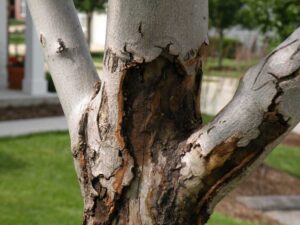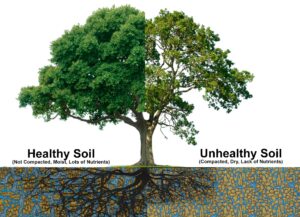Learn to recognize these common symptoms that may save your tree
We think of trees at as stalwart sentries, watching over our yards and weathering any storm with us. Though they seem impervious to the changing world around them, like us, trees can become stressed.
Stress in a tree can lead to disease, die-back, decay, and even death if not addressed quickly. There are many factors in a tree’s life that can stress it out, but they can typically be categorized into one of two kinds of stresses: biotic or abiotic.
In this post, we will take a brief look at abiotic stress and its typical symptoms to help you better recognize possible problems with your tree:
What is Abiotic Stress?
Abiotic stresses are caused by changes in the environment, such as precipitation, heat, soil, etc., around the tree that alter or interfere with the tree’s natural processes.
These can be harder to diagnose because they can take several years to manifest in visible ways. Abiotic stresses on a tree can also be troublesome when the needs of the tree conflict with our outdoor aesthetic.
Biotic Stress Symptoms
Sunscald
 Sunscald affects the southern facing side of the trunk of thin barked trees or young trees planted close to reflective surfaces like concrete. It occurs when too much direct or reflected sunlight comes into contact with the bark of a susceptible tree, causing damage and burning back tissue from the trunk.
Sunscald affects the southern facing side of the trunk of thin barked trees or young trees planted close to reflective surfaces like concrete. It occurs when too much direct or reflected sunlight comes into contact with the bark of a susceptible tree, causing damage and burning back tissue from the trunk.
If you notice a large lesion starting to form on the trunk of your tree, try planting something that will black some of the sun during the day or covering the area with a reflective wrap or paint.
Drought
Experienced in exceptionally hot summers, drought stress can become very common, particularly in younger or newly planted trees.
If you notice the leaves on your tree start turning brown and crispy around the edges or prematurely fall, there is a good chance it needs a long deep watering.
Overwatering
This may not seem like it would be a problem, but there are certain trees that do not like to have their roots sit in saturated soil for too long or they develop root rot. Overwatering becomes a problem when you want to keep your trees and also keep your grass green.
In particular, decline in stands of Post Oaks have become more and more common as subdivisions expand and the green lawns of suburbia demand more water. Unfortunately, the symptoms of over watering a tree do not become visible until it is too late and much of the roots of the tree have already died.
If you notice the bark flaking off the base of the tree or sudden fungal growth around the base of the tree, the tree has become a hazard and you need to consult an arborist immediately.
Soil Compaction/Disturbance


Without the proper amount of air and water in the soil, the roots of the tree with atrophy and die. Compacted soil also physically hinders the growth of new roots from the tree. The decline in root structure of a mature tree can cause die back and even death of a tree.
Soil can be re-compacted, but it is better to avoid compaction whenever possible. Like overwatering, symptoms of soil compaction may not be visible for several years.
Having a mature, old tree in front of your newly built house may seem like a dream, but years down the line, the disturbance to the soil from construction may end up killing the tree without proper mitigation techniques.
When considering the state of a tree, it is important to recognize whether the symptom you are looking is the primary stress or a secondary problem taking advantage of the trees weakened state. This can be difficult to distinguish but is imperative to properly diagnose the needs of your tree.
If you suspect your tree is unhealthy, call your local, friendly, certified arborist to consult on the best course of action to save or mitigate damage to your tree.
